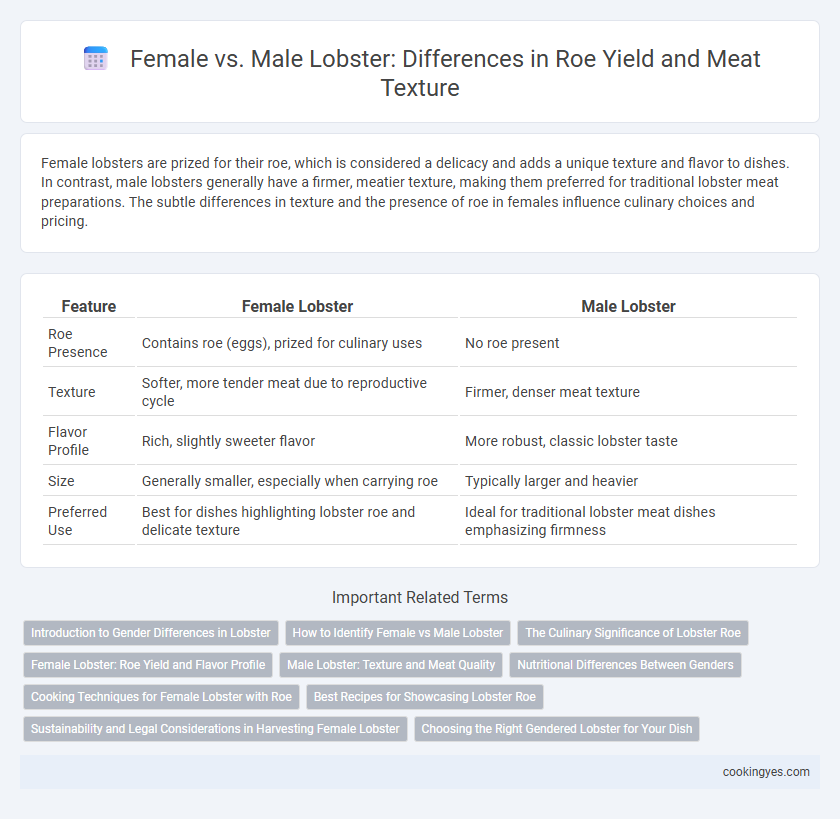Female lobsters are prized for their roe, which is considered a delicacy and adds a unique texture and flavor to dishes. In contrast, male lobsters generally have a firmer, meatier texture, making them preferred for traditional lobster meat preparations. The subtle differences in texture and the presence of roe in females influence culinary choices and pricing.
Table of Comparison
| Feature | Female Lobster | Male Lobster |
|---|---|---|
| Roe Presence | Contains roe (eggs), prized for culinary uses | No roe present |
| Texture | Softer, more tender meat due to reproductive cycle | Firmer, denser meat texture |
| Flavor Profile | Rich, slightly sweeter flavor | More robust, classic lobster taste |
| Size | Generally smaller, especially when carrying roe | Typically larger and heavier |
| Preferred Use | Best for dishes highlighting lobster roe and delicate texture | Ideal for traditional lobster meat dishes emphasizing firmness |
Introduction to Gender Differences in Lobster
Female lobsters, often prized for their roe, exhibit distinct textural differences compared to male lobsters, with the roe adding a rich, unique flavor profile highly sought after by seafood connoisseurs. In contrast, male lobsters typically possess firmer meat but lack the roe, influencing culinary uses and market value. Understanding these gender differences aids chefs and buyers in selecting lobsters that best suit specific dishes and flavor preferences.
How to Identify Female vs Male Lobster
Female lobsters can be identified by the presence of small, soft swimmerets (pleopods) under their tails, which are used to carry roe, whereas male lobsters have hard, bony swimmerets. The roe, or eggs, found in female lobsters provide a distinct flavor and are prized for culinary uses, making the texture of female lobster meat slightly richer and more delicate compared to males. Examining the first pair of swimmerets and the width of the tail helps differentiate gender, with females generally having wider tails to accommodate egg carrying.
The Culinary Significance of Lobster Roe
Female lobster roe, also known as coral, is prized for its vibrant color and delicate texture, adding distinct richness to culinary dishes. Male lobsters lack roe, making female specimens more sought after for recipes that feature roe as a key ingredient, such as lobster bisque or sauces. The roe's flavor intensity and succulent texture significantly enhance the gastronomic experience, underscoring its importance in gourmet seafood cuisine.
Female Lobster: Roe Yield and Flavor Profile
Female lobsters, prized for their roe yield, offer a unique culinary experience with their bright orange eggs known for rich, briny flavor and slightly crunchy texture. The roe provides a delicate, umami-rich taste enhancing gourmet preparations, distinguishing female lobsters in luxury seafood markets. Compared to males, female lobster meat tends to be sweeter and more tender, making them ideal for dishes emphasizing flavor complexity and texture variety.
Male Lobster: Texture and Meat Quality
Male lobsters typically have firmer, denser meat compared to female lobsters, which is highly valued by chefs and seafood enthusiasts. The texture of male lobster meat is often preferred for its slightly sweeter flavor and consistent quality, making it ideal for grilling, steaming, and boiling. Unlike female lobsters, which are prized for their roe, male lobsters provide superior meat yield and texture for culinary uses.
Nutritional Differences Between Genders
Female lobsters contain roe, which is prized for its delicate texture and rich nutritional profile, including higher levels of omega-3 fatty acids and antioxidants compared to males. Male lobsters typically offer denser meat with slightly higher protein content but lack the nutrient-rich roe that enhances the female lobster's culinary and health value. These differences make female lobster roe a sought-after ingredient for its unique blend of essential fatty acids, vitamins, and minerals.
Cooking Techniques for Female Lobster with Roe
Female lobsters, recognized by their roe or eggs, offer a distinct culinary experience due to the unique texture and flavor of their roe compared to male lobsters. Cooking techniques such as steaming or boiling at controlled temperatures help preserve the delicate roe texture, enhancing its creamy and rich taste without overcooking. Incorporating gentle heat and minimal handling ensures the roe remains intact, providing a premium ingredient prized in gourmet seafood dishes.
Best Recipes for Showcasing Lobster Roe
Female lobsters are prized for their roe, which adds a rich, briny flavor and a delicate texture highly sought in gourmet dishes like lobster roe bisque and lobster roe pasta. The roe's vibrant orange color and creamy consistency provide a distinct taste experience, making female lobster ideal for recipes focusing on luxurious seafood textures. Male lobsters, lacking roe, are preferred for their meat's firm texture, but only female lobsters deliver the essential roe element that elevates specialty lobster recipes.
Sustainability and Legal Considerations in Harvesting Female Lobster
Female lobsters are often prized for their roe, which is considered a delicacy, while male lobsters are typically preferred for their meat texture due to their larger claws and firmer flesh. Sustainable lobster harvesting regulations frequently restrict the capture of egg-bearing females to protect reproductive populations and support ecosystem balance. Legal considerations vary by region but generally enforce size limits and seasonal closures to ensure the conservation of female lobsters and maintain fishery sustainability.
Choosing the Right Gendered Lobster for Your Dish
Female lobsters are prized for their roe, which adds a rich, delicate flavor and unique texture ideal for gourmet dishes. Male lobsters typically have firmer meat with a denser texture, making them suitable for recipes that require robust lobster flavor and meat that holds up well to grilling or boiling. Selecting female lobsters enhances dishes featuring roe-based sauces or garnishes, while male lobsters provide optimal meat quality for classic lobster preparations.
Gendered (female) lobster vs Male lobster for roe and texture Infographic

 cookingyes.com
cookingyes.com